Illinois Aerospace Institute Designed to Launch Campers into Aerospace Careers
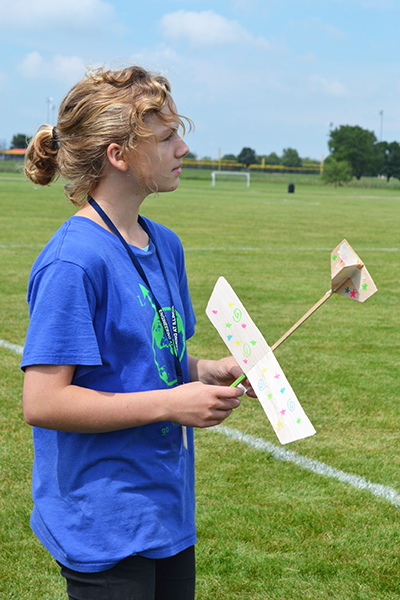
Sarah Perdekamp, the youngest camper in the 2014 IAI, waits to launch her glider during the Friday afternoon "Fly-Off."
July 30, 2014
For a high school student who might be considering a career in aerospace, spending a week at the 23rd annual Illinois Aerospace Institute (IAI) summer camp held the week of July 20–26, 2014, was a step in the right direction. Not only were the 40 students who attended briefed about different careers available, they learned some aerospace basics, including aerodynamics, rocket propulsion, UAVs, and orbits. But students did more than just gain some head knowledge; they got their hands on some fun stuff too. They not only practiced flying in a simulator, but got to fly a real prop plane and to launch some rocket engines. And the highlight of the camp for many participants was a chance to not only design and build both a model rocket and a glider, but to test how well their aircrafts performed in flight at the camp's Friday afternoon "Fly-Off."
The 40 rising high school students (and one eighth grader), who hailed from near and far, heard about the camp in a variety of ways. For example, Sarah Perdekamp (left), who will be entering the eighth grade next fall and lives nearby in Champaign, Illinois, says her mother told her about IAI; another camper, rising sophomore Noa Seward, from Madison, Wisconsin, says she discovered the camp via Google. How did rising freshman Adam Humphrey, all the way over in Corvallis, Oregon, find out about the camp? In a book offering "300+ tips to get into any college you want," he says. After researching the five camps mentioned in the book's Aerospace section, he selected this one.
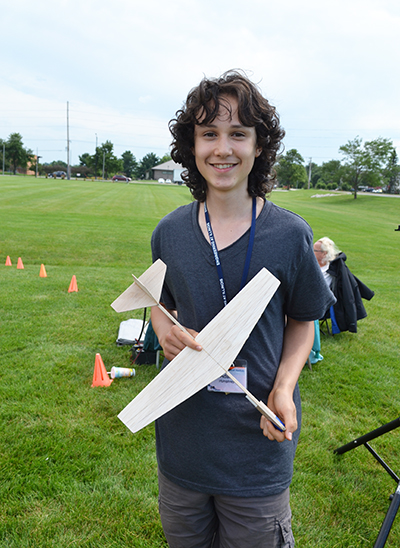
Adam Humphrey waits to launch his glider during Friday afternoon's "Fly-Off."
Campers' career interests were as varied as their places of residence. For instance, Perdekamp reports attending IAI "Because I'm really interested in space, especially. And I love math; that's my favorite subject in school." What did the soon-to-be eighth grader think of the camp? "I've liked it a lot; we've done a lot of creative things, and I thought the rockets were the best. I loved the rockets." How'd her rocket do? Her flight went ok, but she indicates the landing wasn't so smooth. Her rocket landed on the pavement and broke.
Adam Humphrey's career aspirations are to become a fighter pilot, then an astronaut. How did Humphrey like the camp? He called it "incredible." He goes on, "The dorms are awesome; the people are great (especially the counselors), and everyone here is awesome…So I totally recommend coming to this camp." What were his favorite things? The astronautical lessons and getting to fly a small training prop out at the University's Flight Star at Willard Airport. "I scared the heck out of my Brasilian buddy who was in the plane," admits Humphrey. "I was the only person they let take off."
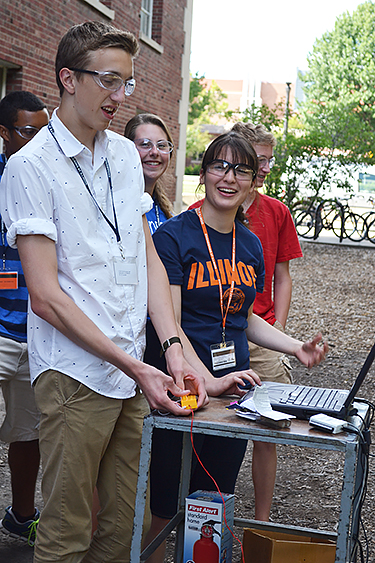
Above: Marianne Monastero (center, at the laptop) and some IAI students enjoy a "launch" as the student on the left ignites a model rocket engine, allowing them to measure its thrust output.
Below: An IAI camper has just ignited one of the model rocket engines.
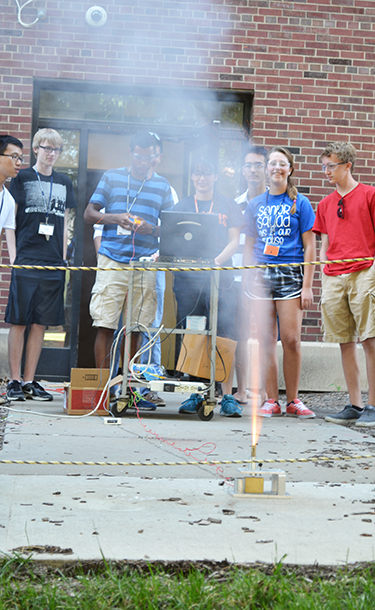
How did Humphrey's rocket and glider do? While his rocket was in 2nd for a little while (it got to 796 feet), he had problems with his glider: "The engine was too tight, so it blew off. "
Noa Seward, a rising sophomore, indicate's she's been interested aeronautics since the end of 6th grade. Seward wants to be an aerospace engineer. She reports that her favorite thing about IAI was building the rockets and gliders. How'd her rocket do? "It ran into a car the first time," she admits. "So we'll see." Does she want to attend Illinois? "If I can get in," she says.
One of the camp's many engaging activities, a rocket propulsion lab, was reminiscent of a real rocket launch at Cape Canaveral. Aerospace Engineering Ph.D. student Marianne Monastero first taught the students some theory behind rocket propulsion, then she and her class adjourned to the Quad for the hands-on portion. Complete with a countdown, the activity had plenty of noise, smoke, and fire, as students ignited four different model rocket engines of various capacities to measure their thrust output and compare their performance. The activity allowed the students to calculate the theoretical height that they could expect their model rockets to reach from the measured thrust-time curve of one of the engines.
According to Monastero, during the activity, "The students learned some of the basics of rocketry, practiced using the kinematic equations that govern rocket motion, and gained hands-on experience in performing an experiment and analyzing data."
While it was her first summer teaching IAI, Monastero's no stranger to aerospace summer camps; she taught G.A.M.E.S. for the last two summers. Why take time from her quest for a Ph.D. to teach high schoolers?
"I think it gives them motivation and excitement for math and science so that they know this is a career option, and it's something that they're capable of doing," says Monastero. "And it's fun; it shows them that there's more to do than they might necessarily know they can do. So I think it just exposes them to new careers and helps them move ahead in math and science."
Does Monastero think any of the students at this year's IAI camp will end up in Aerospace Engineering? She thinks so:
"With my experience with the G.A.M.E.S. camp, I know that some of the girls have gone into engineering in college. I keep in touch with a few of them, so I've seen them go into engineering. And from what I hear from other people, they do go into aerospace eventually." For example, some former G.A.M.E.S. campers will be studying Aerospace Engineering at Illinois beginning this fall.
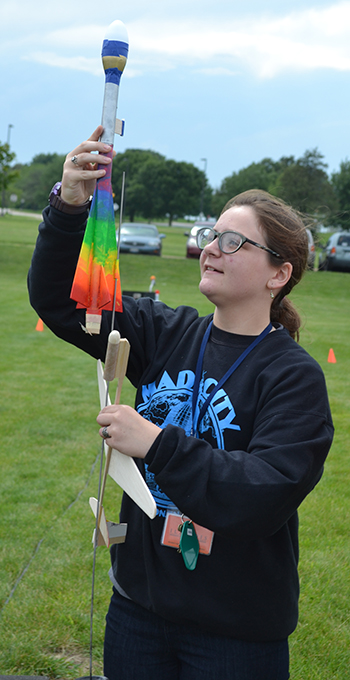
Noa Seward prepares to launch her glider during Friday afternoon's "Fly-Off."
Brian Woodard, co-director of the camp, also thinks some of the IAI campers will be aerospace engineers in the future. "These guys were really good. Very creative with their rocket designs this time. We saw some recently that were a little more boring, but these guys did a really good job."
Why does Woodard, who also helps run the Aerospace Engineering G.A.M.E.S. camp, devote two weeks of his summer to running these camps? He hopes to recruit some of these students to Aerospace Engineering at Illinois.
And Woodard knows first-hand the impact the IAI camp can have on a high school student poised to choose a career path. He himself attended the camp in 1996 after his junior year in high school. Says Woodard, "I was pretty sure that I wanted to be an engineer and was interested in Aerospace. After attending the camp, I knew that I wanted to be in Aerospace, and knew that I wanted to go to Illinois. Luckily, I got accepted here and the rest is history, I guess."
The "rest" is that Woodard went on to earn his B.S., M.S., and Ph.D. degrees in Aerospace Engineering at Illinois. Currently a teaching associate in the department, he's interested in high-energy lasers, aerodynamics, and aircraft icing. However, Woodard has still another interest: piquing the interest of highschoolers who have yet to choose a career, in hopes of steering them into aerospace. Thus, his participation in Aerospace's IAI and G.A.M.E.S. camps.
"I really like working with all the high school students," admits Woodard. "I think it's so fun to get them interested in aerospace, and hopefully we'll see a lot of these faces in a couple of years in the department."
Story and photographs by Elizabeth Innes, Communications Specialist, I-STEM Education Initiative.
More: 8-12 Outreach, Aerospace Engineering, Summer Camp, 2014
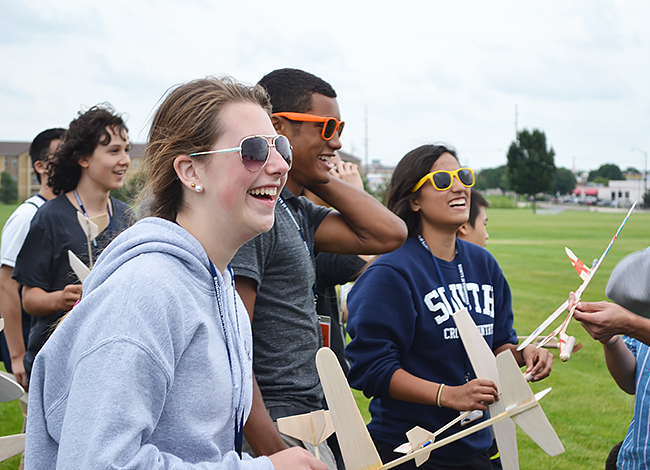
Several 2014 IAI campers enjoy the flight of one of their fellow camper's aircrafts.













.jpg)
















